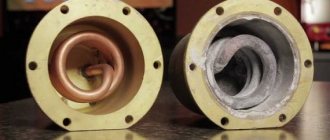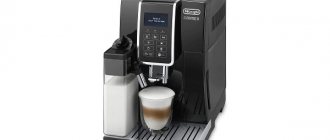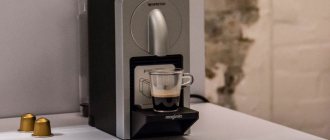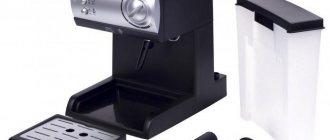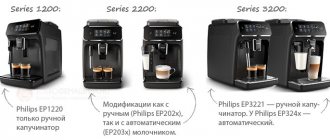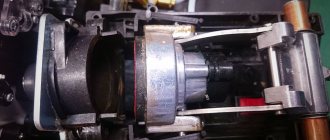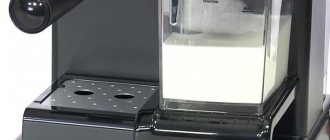Coffee maker DeLonghi EN 520 characteristics
| A country | Italy |
| Manufacturer's warranty | 24 months |
| ARE COMMON | |
| Type | Capsule |
| Pressure | 19 bar |
| Power | 1300 W |
| Type of coffee used | Capsules |
| Type of capsules used | Nespresso |
| PREPARE COFFEE | |
| Espresso | Eat |
| Cappuccino | Eat |
| A HEATING ELEMENT | |
| Type | Thermoblock |
| BUILT-IN EQUIPMENT | |
| Cappuccino maker | Eat |
| WATER TANK | |
| Water tank volume | 0.9 liters |
| Water tank material | Plastic |
| Removable water tank | Eat |
| COFFEE TANK | |
| Filter type | Constant |
| ANTI-DRIP SYSTEM | |
| Removable drip tray | Eat |
| FUNCTIONS | |
| Preparing boiling water | Eat |
| Portion volume adjustment | Eat |
| Auto shutdown | Eat |
| CLEANING | |
| Automatic decalcification | Eat |
| CONTROL | |
| Type | Electronic |
| INDICATION | |
| Water level | Eat |
| Inclusion | Eat |
| Ready to go | Eat |
| FRAME | |
| Waste container | Eat |
| Power cord compartment | Eat |
| DIMENSIONS | |
| Height | 31.9 cm |
| Depth | 25.3 cm |
| Width | 16.7 cm |
| Weight | 4.5 kilograms |
| Color | Black color |
Comparative review of capsule coffee machines DeLonghi EN 520, DeLonghi EN 80 and Bosch TAS2001EE
Expensive and simple
Table of contents
- DeLonghi EN 520
- Conclusion
- DeLonghi EN 80
- Conclusion
- Bosch TAS2001EE
- Conclusion
- General conclusions
In this issue we will again talk about capsule coffee makers.
This topic has already been touched upon in our section: in this material you can read about two specific models, Krups Mini Me and DeLonghi Essenza EN 97.W, as well as learn about the operating principle of a capsule coffee machine, the structure of the capsule itself and the range of flavors. The story of capsule coffee makers began back in 1986, but is unfolding before an observant public right now. Nestle, which was once a monopolist on the capsule coffee maker market, is losing its momentum and losing patent trials. There are more and more manufacturers of capsules compatible with Nespresso machines around the world. Business analysts call the coffee disputes that have been going on for several years “capsule wars” and follow them with some interest.
DeLonghi Nespresso Lattissima+ EN 520
This is the most powerful and most expensive model from our triple review. The machine runs on Nespresso capsules, has a pressure of 19 bar, a built-in milk preparation system, as well as the combination of compactness and pleasant appearance characteristic of DeLonghi devices.
Characteristics
| Manufacturer | DeLonghi |
| Model name | Nespresso Latissima+ EN 520 |
| Power consumption | 1300 watts |
| Housing material | plastic |
| Case color | black |
| Water tank volume | 0.9 l |
| Coffee type | Nespresso capsules |
| Control type | mechanical buttons |
| Additional functions | adjusting the portion of hot water, making cappuccino and latte |
| Pressure | 19 bar |
| Size | 17×24×30 cm |
| Weight | 4.5 kg |
| average price | T-7689539 |
| Retail offers | L-7689539-10 |
Equipment
- coffee machine
- milk preparation system
- power cable
- instructions
Instructions
Not the simplest and most understandable. All the difficulties with studying it lie in the layout and publication of a multilingual brochure. A drawing of the parts of the device is located, as is usually the case, on the first pages of the book, and the text in Russian and Polish is in the middle. The instructions are made in the form of the now popular genre of step-by-step pictures with explanations. With pictures and inscriptions everything is completely clear, but the need to understand multi-colored pieces of text in two languages at once, periodically looking at the beginning of the brochure and trying to understand where the layout has moved and which picture this inscription refers to is a little tiring.
Control
A coffee machine is a device that initially implies the ease of preparing a portion of a quality drink. In this sense, the DeLonghi Nespresso Lattissima+ EN 520 meets the requirements: after mastering a number of simple procedures, controlling the model becomes easy and becomes automatic. To get the usual portion of coffee, you need to insert the capsule into the container and press the button corresponding to the desired drink.
It is impossible to operate the machine without instructions; the device is equipped with a complex system of light signals and requires compliance with a number of procedures (including flushing the system after first use and descaling). In domestic use, the most difficult tasks are regularly emptying some tanks and filling others. We described this part of daily practice in the “Care” section below.
The machine has three user-programmable functions: water volume per serving, water hardness setting and automatic shut-off time. The last one will turn off your device by default after 9 minutes of inactivity. You can reprogram the device to turn off after 30 minutes or after 8 hours of non-use. The process is quite simple: the user turns off the machine, then selects the button corresponding to the desired period of shutdown, presses it and holds it while turning the machine on. So, for nine minutes (factory setting) it is a lungo button, for half an hour it is an espresso button, and for eight hours it is a combination of espresso and lungo buttons.
Programming the water level per serving is done while the machine is running while making coffee. The user charges the capsule, selects the button for the desired drink and holds it down until the desired volume of liquid is reached in the cup. After this, you need to confirm the volume by pressing the button that flashes three times: now the machine will give you exactly this amount of drink by default. In this way, you can program not only the volume of water in espresso and lungo, but also the strength of cappuccino and latte, as well as the amount of milk foam. Setting the water hardness level follows the same principle as setting the auto-off time, only with buttons for latte, cappuccino, and their combination. The user takes the required level of hardness from the table in the instructions.
If you want to reconfigure the car for yourself and reset someone else's settings, the easiest way is to use the factory reset function. To do this, with the machine turned on, press all 4 drink selection buttons and hold for 5 seconds. After this, the buttons will blink three times, thus indicating a successful return to factory settings.
The device has a built-in cappuccino maker. This does not save the user from a certain amount of fuss around milk foam: the system for preparing milk must be assembled, rinsed after preparing the drink using a special button, and a couple of times a week (with frequent use) disassembled and washed in the dishwasher. For this, the machine itself will whip up milk foam for you and make a latte.
Exploitation
Before installation, the instructions instruct you to remove the water tank, container for used capsules and drip tray from the device. After installing the coffee machine and connecting the cable to the network, you need to rinse the water tank and fill it with drinking water. After plugging in for the first time or after a long break in operation, the machine must warm up the system: this process takes 40 seconds after switching on, and is indicated by the flashing of the espresso and lungo keys. When the appliance is ready for use, the drink preparation buttons stop flashing and begin to glow steadily. After completing this stage, you need to rinse the system by pouring water from the coffee outlet into any container using the “Lungo” button. This procedure must be repeated at least three times before starting to prepare drinks.
Care
Cleaning a coffee machine can be done at home (after preparing a drink) or regularly (descaling, rinsing the milk preparation system). With daily (household) care everything is quite simple. Removable parts - grilles, drip tray, water tank, capsule container - can be washed under running water. The housing should be wiped with a damp soft cloth and a mild detergent. The only part of the device that, according to the instructions, can be placed in the dishwasher is the milk preparation system. It consists of a milk container with a spout, a lid and a milk foam height regulator.
Descaling occurs at the request of the machine itself: the cappuccino button starts flashing orange. Before starting the process, all tanks in the device must be emptied. Cleaning occurs using a special branded product, which is poured into a tank of water in a ratio of 1:5 (100 ml of product per 500 ml of water). The model comes with a special nozzle for descaling, which is installed in the steam connector. To spill the system, you need to arm yourself with a container whose volume is at least a liter. The machine will dispense product alternately through the coffee spout, descaling nozzle and drip tray. The end of the process will be indicated by an orange indicator on the cappuccino button. The procedure must be carried out five times in a row.
Testing
We measured the time it took each of the machines we tested to prepare espresso. DeLonghi EN 520 makes a cup of drink in 27 seconds. Our subjective assessment of the taste of the drink is high: rich coffee, strong foam (creama) on the surface.
Everything else that can be said about the taste depends on the user’s actions: the choice of capsules, the programmable volume of ingredients, the quality of water. By the way, the device accepts non-original capsules, but does not throw them into the container for used capsules - you will have to remove them yourself and throw them away one at a time. Our subjective experience also suggests that the original capsules provide a stronger and tastier drink. This, however, is not surprising: there should be a high sense in paying a lot of money for a brand.
The operation of the cappuccino maker also depends on the quality of the milk. The system must be filled with sterilized milk cooled to 4 °C. If this condition is met and the milk has sufficient fat content, we get a fairly strong, high foam. Our experiments have shown that milk with a fat content of 2.8% to 3.2% is well suited for making both cappuccino and latte.
Measurements with a wattmeter confirm the power declared by the manufacturer: the device consistently showed 1300 W when preparing espresso and approximately 1250 W when heating the system.
After studying user reviews online, we found a noticeable number of reports that the machine's body overheats, as well as about the machine breaking down after a few months of use. We can neither confirm nor deny this information, so we simply suggest you study other people’s experience of using the model.
Conclusion
If you are not afraid of the price of the device itself and the cost of the capsules, then our testing team cannot offer you any other complaints about the performance of this model. The machine is easy to operate, not too difficult to maintain, and makes milk foam and lattes on its own. The device operates quite quietly, the sound level does not force you to go to another room for a telephone conversation. There is also, of course, the eternal debate between sharp- and blunt-edged people about the choice of capsule manufacturer. If you like Nespresso capsules or don’t see the difference, then there’s no problem for you either.
But negative user reviews are information for thoughtful study. There are no fewer positive comments online than negative ones, but the truth, as usual, lies somewhere on the side.
pros
- simple controls
- built-in milk preparation system
- fast and quiet operation
Minuses
- negative reviews about long-term experience with the device
- Working with an automatic cappuccino maker requires a lot of steps
DeLonghi Espresso Inissia EN 80
The model is from the same manufacturer as the first experimental model, but simpler and more compact. Like everything made by DeLonghi, the device combines compactness and stylish appearance, and the laconicism of the form and content of this model was a success. Narrow body, two buttons (espresso and lungo), handle for capsule compartment. The appearance also does not disappoint, the model looks elegant and modern. We received a device in a blue (as this color is called in the documentation) case.
Characteristics
| Manufacturer | DeLonghi |
| Model name | Nespresso Inissia EN 80 |
| Power consumption | 1260 watts |
| Housing material | plastic |
| Case color | blue |
| Water tank volume | 0.7 l |
| Coffee type | Nespresso capsules |
| Control type | mechanical buttons |
| Additional functions | adjusting the amount of hot water |
| Pressure | 19 bar |
| Size | 23×15×26 cm |
| Weight | 3.6 kg |
| average price | T-10725005 |
| Retail offers | L-10725005-10 |
Equipment
- frame
- water tank
- power cable
- instructions
Instructions
The manual for the device is criticized by almost all users who leave reviews online. Our team will join the voice of the crowd. The instructions are a multi-page brochure with a minimum of text in several languages at once and with pictures. This is the now popular comic book type of guide that we usually praise. But in this case, the comic is more like a rebus; the accompanying text tells us only the title of the section, and to clarify all the questions, the brochure draws us a phone icon. I mean, call the service center, they will tell you everything. This reality of interaction with technology, about which we should know nothing, since we are not specially trained people, is not new and is already almost familiar. But some users still want to understand a little more and call technical support a little less often.
Control
If in the case of the previous model we wrote that you cannot do without instructions, then this time we recommend avoiding communication with instructions. In addition, there is nothing complicated in ordinary household cohabitation with the DeLonghi EN 80. The device has two mechanical buttons: espresso and lungo.
To make yourself a cup of coffee, you need to wake the machine from energy-saving mode by pressing either of the two buttons. When the indicators light up steadily, you need to insert the capsule into a special compartment and lower the handle on the body. The compartment with the capsule will go deeper, and the capsule will be punctured. Now you need to press the button for the desired drink. Pressing once will give a standard portion of coffee (40 ml for espresso and 110 for lungo). By holding the key, you can program the volume of water in the drink yourself. The machine remembers the user-selected desired volume, but you can reset your program and return to factory settings by turning off the unit and then pressing and holding the lungo button for 5 seconds. The machine is turned off by briefly pressing both buttons simultaneously.
Among the programmable settings, the DeLonghi EN 80 also has an auto-shutdown period. The default period is 9 minutes, you can configure it to turn off after 3 minutes or after half an hour of inactivity. To set a period of 3 minutes, turn off the machine by pressing both buttons at the same time, then hold down the espresso button for 3 seconds. The blinking indicator will let you know that the program has been recorded. To configure automatic shutdown after half an hour of inactivity, turn off the device and press the espresso button twice.
Exploitation
After installing the device and connecting it to the network, it is necessary to flush the system according to the same principle as with the first machine we described. We pour water into the reservoir, turn on the device without the coffee capsule, place the container under the drink spout and drain the water. The procedure according to the instructions must be repeated three times.
To operate normally, the machine needs to warm up, this takes 35 seconds. The device turns on using one of two buttons (espresso and lungo); during warming up, the keys flash. When both indicators light up solid green, the machine is ready for use.
Care
As in the previous case, care is divided into household (permanent) and regular (descaling). Household care includes changing the water in the tank, emptying the container for used capsules, emptying and rinsing the drip tray, and cleaning the spout and body of the device with a damp soft cloth. The instructions do not recommend putting any parts of the device in the dishwasher.
Descaling occurs, depending on the water hardness, after 1000, 2000 or 4000 cups of coffee. To carry out the procedure, you will need a special product and any instructions for descaling a capsule coffee machine, except for the one included with the device. This machine does not have any special nozzles for cleaning; the liquid is poured through the system and exits through the “natural openings” of the device. The user’s task is to equip yourself with a container to collect liquid and patiently repeat the cleansing procedure 5 times in a row.
In general, the device is completely unpretentious in everyday life, especially if it is used regularly - the owner quickly “turns on the autopilot.” The most difficult thing in caring for the device is, perhaps, buying capsules at reasonable prices.
Testing
We fill the reservoir with fresh purchased water and turn on the device. After the machine warms up for 35 seconds, the indicators begin to glow solid green. We insert the capsule into the compartment, press the handle, then press the espresso button. A standard portion of the drink (40 ml) takes 18 seconds to prepare. The taste of coffee, as usual, depends on many factors, including the chosen capsule.
For the first test of the first and second machines, we take the original Arpeggio flavor capsules. We arrange a blind test: we make identical portions of espresso in DeLonghi EN 520 and EN 80. The taster chooses the drink prepared in EN 520. It is richer, has a strong crema (foam on the surface). The test operator reports that this coffee took 9 seconds longer to brew (the DeLonghi EN 520 makes a standard shot of espresso in 27 seconds). Nevertheless, the coffee prepared in the DeLonghi EN 80, in our subjective assessment, tastes very good.
The device does not make much noise when making coffee, without drowning out conversations in the room. The body of the machine heats up during operation, but this becomes noticeable only after preparing the third cup of drink, if the portions are made in a row.
This device, like the previous one, does not throw non-original capsules into the tank after use. In addition, non-original capsules must be handled more carefully during installation, otherwise the machine may not pierce them and disrupt their shape, after which it is almost impossible to install the capsule again. We mentioned our subjective comparison of the taste of original and non-original capsules in the description of DeLonghi EN 520.
Measurements of the wattmeter on the device gave us the following results: 1000 W during heating, 1115 W when preparing espresso.
Conclusion
This is an easy-to-use, compact model that allows you to prepare a cup of coffee in less than a minute. A convenient option for many households and offices. In addition, this is a device that looks interesting and is supplied by the manufacturer in several colors. Due to its compactness and ease of operation, we lose a little in the range of drinks and a little in the quality of taste. The only inconvenience of the design is the water tank located on the rear panel of the device. As a result, it is necessary to install the device so that there is easy access to the container. It is worth mentioning some difficulties with using non-original capsules - this, taking into account the state of prices for consumables, becomes an important nuance when choosing a capsule coffee machine.
pros
- compactness
- ease of operation
- nice appearance
Minuses
- difficulty using non-original capsules
- water tank located at the rear wall
- unclear and incomplete instructions
Bosch Tassimo Amia TAS2001EE
This is a completely different reality of making coffee at home. The device is quite cheap, simple in appearance and control method. This machine is not fueled by capsules, but by T-discs. Their point is not to quickly and easily make a good cappuccino, but to expand the range of flavors for the user of capsule coffee machines without losing ease of use.
The model is small in size and fits easily in the kitchen. The white color makes it indistinguishable among most household appliances and tools. Tassimo Amia is quite lightweight and can be easily moved from place to place if the need arises.
Characteristics
| Manufacturer | Bosch |
| Model name | Tassimo Amia TAS2001EE |
| Power consumption | 1600 watts |
| Housing material | plastic |
| Case color | white |
| Water tank volume | 1.5 l |
| Coffee type | Tassimo T-discs |
| Control type | mechanical buttons |
| Additional functions | adjusting the amount of hot water |
| Pressure | 3.3 bar |
| Size | 27×19×28 cm |
| Weight | 2.4 kg |
| average price | T-7718405 |
| Retail offers | L-7718405-10 |
Equipment
- coffee machine
- power cable
- instructions
Instructions
The instructions for the device are a brochure with a separate section in Russian. This already makes life easier for the user, although the page with the device diagram, as usual, is located at the beginning of the brochure and when studying the book you will have to leaf through it, comparing the illustrations with the picture.
The manual is very detailed: for each user step there is a paragraph of detailed text explanation and a picture. Sometimes you get the impression of explaining obvious things too carefully, because the car is really very easy to operate. But in the case of instructions, this is rather a virtue. It is worth carefully studying the sections about the service disk and about the operation of indicators.
Control
This machine is not designed exactly the same, and in some ways completely different, from Nespresso capsule machines. So-called T-discs can contain not just ground coffee, but a dry extract of drinks: latte, cappuccino with different flavors, tea, cocoa. A scanner inside the disc bay reads the barcodes on the disc packaging and launches the desired program. The user in this system only controls the amount of water per drink. The machine has one large start button and four indicators above it: manual and automatic mode, liquid level and descaling.
The device supplies water under low pressure (3.3 bar compared to 19 bar for the two models described above). The method of brewing a drink using T-discs differs from the capsule system. The coffee powder is not compressed in the disc, and water is supplied to it through several channels. In this material you can find a diagram of the passage of water through a disk with coffee and milk concentrate. From the same text you can learn about the economical calculation of hot water by the machine per serving of drink. In a nutshell: the device reads information about the amount of water from the barcode, passes it through a flow meter and two thermostats, after which the liquid enters the disk.
The user can change the amount of water per drink. To reduce the amount of liquid, you need to start cooking and press the button again. The water supply will be stopped. To increase the amount of drink, you need to wait until the end of preparation - the machine will switch from automatic to manual mode, switching the indicator accordingly. In manual mode, you can press and hold the button, thus adding hot water to the cup.
In general, control of the device is more than simple, and the only entertainment the user gets is a choice of flavors from an assortment of discs. The assortment, however, is not very large on the Russian market. Fillers for our market are sold under the Jacobs Monarch brand, and in stores the choice of flavors of original discs is not amazing in scope. Typically these are espresso, cappuccino with several flavors, latte, cocoa and tea.
Exploitation
After installing the device and connecting it to the network, it is necessary to carry out the first flushing of the system. This allows, among other things, to get rid of the smell of plastic, which is felt in this model at the beginning of use. Now you need to pour water into the tank, turn on the device, wait until it warms up.
The TAS2001EE has a special service T-disk for cleaning the system, it is stored in a compartment on the rear panel; to remove the disk from the hole, you must first remove the water tank. The disc is placed in the disc compartment, and the largest cup possible is placed on the tray. After this, you need to close the disc compartment until it clicks and press the start button - the device will begin self-cleaning. The procedure must be performed 5 times, emptying the container (cup). After this, the device is ready for use.
Care
Regular maintenance includes filling and cleaning the reservoirs, mandatory cleaning of parts of the disk compartment, wiping the housing, the splash guard (this is the name of the steam spout on this device) and the scanner inside the disk compartment. Some parts of the machine, such as the piercer, disc holder, cup holder, can be placed in the dishwasher. Unlike previous devices, the Bosch TAS2001EE does not dump the used capsule anywhere; it must be removed from the compartment manually and thrown away. But this device has a water level indicator that warns that it’s time to refill the tank.
A special indicator will also inform the user that the machine needs descaling. In this case, as the instructions frighten, the cleaning procedure must be started immediately, otherwise the device will break down and the service center will not replace it. To clean, you need a service disc and a special product, which is poured into an empty water tank to the 0.5 liter mark. Then you need to remove the cup stand and install a container with a capacity of 0.5 liters or more in its place. After installing the service disk, you must hold the start button for 5 seconds. The cleaning program will start and run for 20 minutes. Then you need to rinse the water tank, fill it with fresh water and flush the system several (4 or more) times.
Constant care of the device is not difficult, but some of its nuances subjectively interfere with easy cleaning: the need to remember to wipe the scanner and piercer, the need to throw away the disk after each use of the machine, and the white body on which coffee stains are clearly visible. The last mentioned fact disciplines the user, forcing him to wash the cup stand every time after preparing a drink (or choose a less easily soiled color of the unit when purchasing - red and black are definitely available on the market).
Testing
As in previous cases, the main object of our testing is espresso. As already described above, the manufacturer’s range of T-discs is small, and espresso is just espresso, without a choice of flavors. We heat up the machine, start the disc and get a fairly large portion of the drink. Our measurements of the serving volume showed that the T-disks are programmed more for lungo than for espresso - there was about 90 ml of drink in the cup. Our subjective taste characteristics: weak and unsaturated coffee with undeveloped aroma.
The espresso, which halved the volume of water per shot, was richer but lacked the espresso and crema flavor. This, however, is not surprising, since the drink is not brewed under high pressure, and the powder is not compressed - that is, the preparation technology is not entirely suitable for classic espresso.
Users online mostly praise the device for its ability to make caramel lattes, cappuccino and cocoa. Let's try cappuccino. The foam of the drink is quite believable, but the taste of concentrated milk confuses the receptors somewhat. The overall organoleptic perception of the product suggests that this cappuccino is no worse than many others that were served to us in different establishments at different times. But cappuccino made by DeLonghi EN 520 from espresso and regular milk has a more pleasant aroma and texture.
The device makes a cup of espresso in 46 seconds. The wattmeter showed us 2 Watts at idle and strange jumps during espresso preparation from 0.8 to 800 Watts. The average value of measurements during preparation of the drink is 156 W.
Conclusion
This is a car not for gourmets, but for those who like not to bother. The device is very easy to use, and if you are satisfied with the taste of coffee drinks from chain coffee shops and usually choose not espresso, but a latte with a filler, the Bosch TAS2001EE will please you. In addition, the model is very inexpensive, and sometimes even free - some stores organize promotions, offering the device as a gift with a set of T-disks. But capsules for Bosch Tassimo are not free at all, alas. And, unlike previous test subjects, there are no alternative manufacturers for this capsule format yet.
pros
- cheap model
- ease of use
- T-disks are not only coffee and drinks based on it, but also tea and hot chocolate
Minuses
- subjective lack of taste of coffee compared to a drink from Nespresso capsules
- not a very large range of capsules on the Russian market
- There are no non-original capsules
General conclusions
In this review, we tried to look at the world of capsule coffee machines and comprehend its horizons. It is seriously impossible to compare an expensive DeLonghi coffee maker with Nespresso capsules with a cheap Bosch model with Tassima T-discs. And not because one is good and the other is bad, but because these are completely different products for different audiences. All these devices are united by comparative ease of use at a relatively high price for capsules. If you are willing to pay for the simplicity of the process, this is the place for you. Next, you need to understand what you prefer to shell out for: for coffee snobbery, for maximum simplicity, for a combination of functions, for the brand and build quality. If we discard everything superfluous in the motives for choice, it turns out that in the big world of capsule coffee machines the choice for the Russian user is not so great. Especially considering the prices.
| All coffee makers are provided for testing by Yulmart |
Coffee maker DeLonghi EN 520 reviews
Advantages:
- Nespresso DeLonghi EN 520 small sizes;
- nice design, looks good in the kitchen;
- whips up excellent high foam;
- brews very tasty coffee;
- not too loud;
- works quickly;
- convenient and easy to use;
- minimal maintenance costs;
- prepares delicious cappuccino and latte;
- You can use different types of coffee.
Flaws:
- DeLonghi Lattissima EN 520 prepares only one cup at a time;
- expensive capsules;
- no timer.
Capsule coffee machine DeLonghi Nespresso Lattissima EN 520 reviews are based on 33 user reviews in Yandex Market.
